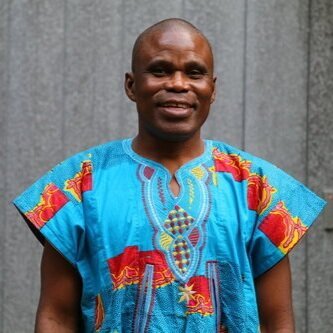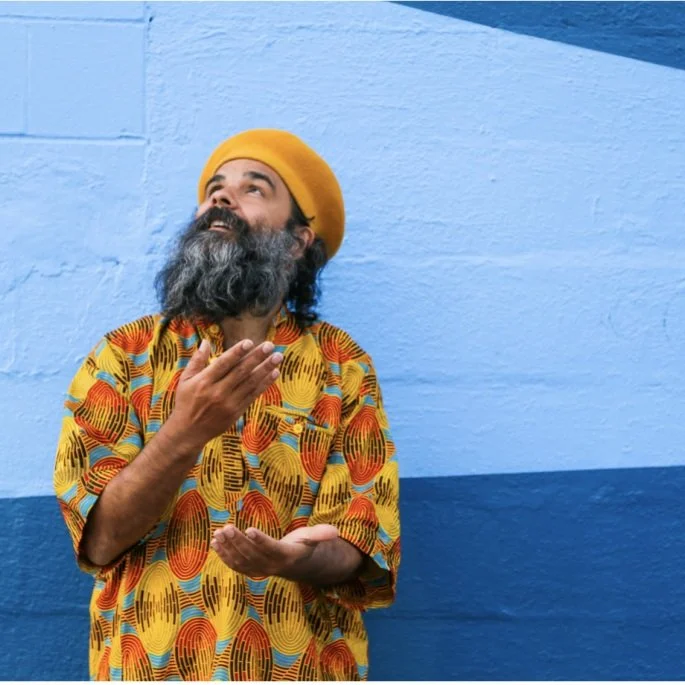African Chamber Music upends stereotypes, as strings meet Ghanaian and Zimbabwean songs
Globetrotting percussionist Curtis Andrews and friends aim to decolonize the idea of Western classical music
Kofi Gbolonyo
Curtis Andrews
The Time Will Tell Arts Society and Caravan World Rhythms present African Chamber Music at the Annex on October 16 at 4 p.m..
AFRICAN CHAMBER MUSIC, a groundbreaking local initiative that brings together musicians from Ghana, Zimbabwe, improvised music, and the European chamber-music tradition, is more than just a concert: it’s an attempt to recalibrate the way we hear.
So far, it seems to be working.
For Curtis Andrews, the globetrotting percussionist who is behind both the event and the Time Will Tell Arts Society, an organization devoted to promoting “music that’s rhythmically vivacious”, the goal is to “decolonize the string quartet and the idea of Western classical music in general” by upending stereotypes of African music while letting African performers take the lead in the collaborative process.
“People have tried putting together classical musicians or string players and ‘ethnic’ musicians before, the Kronos Quartet being of course one of the most popular examples of that,” the Newfoundland-born Andrews says in a telephone interview from his Vancouver home. “And all those kinds of projects have their plusses and minuses, as does this one. But this one, I find it interesting because the aim is not to put what I’m calling the source music, which is the traditional music, in a new light, or make it palatable to a different audience. And we’re not trying to add different kinds of harmonies or certain rhythmic textures that are not inherent in the music. We’re trying to keep that music as it is, and using the strings more to highlight and accentuate the inherent aspects of it. It’s almost like like an amplification, if you will, of what those musics contain already, just with some timbral differences, obviously, with the strings.”
Decolonization, in this case, also involves examining how the development of European art music was fuelled and financed by the slave trade, and rationalized by the denigrating of Africa’s lively and multifarious sonic traditions.
Colonists and slavers, Andrews says, “didn’t see these people as having culture or having music. The music they heard was ‘noise’; it didn’t subscribe to the prevailing European notion of aesthetics and what constituted music. So that sort of continued until recently. It was only until well into the 20th century where these views started to change a little bit, but if you go to any classical-music school, local ones included, you’ll still find attitudes towards non-European musics that are somewhat condescending.
“African music has stereotypes of what it is: it’s loud, it’s drumming, it’s complicated rhythms, it’s a lot of dance, a lot of energy,” he continues. “And that’s all true of different types of African music, but there’s a whole other side of expression in many cultures that’s very contemplative. Very intimate, if you will, with words and songs that are profound and have deep philosophical meaning. So my collaborators, Kofi Gbolonyo and Kurai Mubaiwa, chose songs that lend themselves to that context, because we’re going to be in a sit-down environment. It’s not a dance party, or anything like that!”
Meredith Bates
African Chamber Music’s all-star cast of string players—violinists Meredith Bates and Joshua Zubot, violist Sarah Kwok, and cellist Peggy Lee—had already been thinking about decolonizing themselves before being called for the project. Bates and Lee are part of a musicians’ discussion group that looks at art in a social context, and all four have explored various forms of non-Western music, free improvisation, and African-American jazz. But learning to properly hear Ghanaian and Zimbabwean idioms has been both exciting and challenging.
“We got into a really cool discussion around the idea of pitch, and how for us our Western classical training teaches us that there’s only one right pitch,” Bates notes in a separate phone interview. “We have this idea that we’re trained to blend perfectly and trained to sound like one instrument. But the idea in Kofi’s songs was that pitch was a broader idea. His idea of being in tune was more about the rhythmic elements of the groove than about hitting the pitches exactly in tune together.”
Gbolonyo, a Vancouver-based master musician, singer, and educator with an international following—picks up the thread. “The western perception of pitch—that is to say perfect pitch, absolute pitch, pitch in the sense that a note here should be exactly the same as a note in Germany or in Johannesburg or in Rio de Janeiro—is completely an only-from-one-culture perspective. So, speaking for indigenous Africans—especially from West Africa—pitch should be considered a zone and not a point. In which case, two singers, or two instruments from the same general family, like xylophone and balafon, may not necessarily produce the same absolute pitch for them to be considered in the same pitch zone, as I call it.
“Simply put, Africans—and people from many other musical cultures—have much more pitch tolerance than people who are trained in Western classical music,” he concludes.
Technical considerations aside, the emotional result of this flexibility makes for more nuanced and expressive music, as any fan of blues slide guitar will recognize. And by taking African music outside of the dance-party context that is how it is generally framed in North America, local listeners will hopefully find it easier to hear and understand how nuance is expressed in Gbolonyo’s songs and Mubaiwa’s mbira melodies.
Asked for an example, Andrews, Bates, and Gbolonyo all seize on “Gbomasumasu”, a Ghanaian song that is both a deeply individual statement and a commentary on the benefits of working together.
“It’s sung from the point of view of an eagle, a type of raptor that’s in Ghana,” Andrews explains. “So the bird is saying, basically, that it wishes it wasn’t a solitary bird; it wishes that could fly in numbers the way that other birds do. And what that metaphor is touching on in a larger sense, a deeper sense, is that to have large numbers or to be in a majority—whether it’s in a family or a neighbourhood or a culture or an ethnic group—you generally benefit more. You have strength in numbers.”
“‘United we stand, divided we fall,’ pretty much,” Gbolonyo concurs, adding that the message is also a fit metaphor for how the African Chamber Music players are coming together to make something larger than themselves—and for the immigrant experience that all seven musicians share, whether first-hand or through their near ancestors.
“Coming here, I often feel isolated in terms of my musical taste, my musical power and all of those things, even though I know that there is a part of the world where the musical skills that I have are very, very powerful, and very much appreciated,” Gbolonyo reveals. “Here, I have to try to recruit other people, sort of, to beef up my musical strength.”
Beginning with listening and moving on through practice to performance, African Chamber Music exemplifies that process perfectly.
















